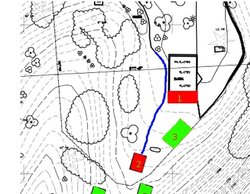I have come across your site a bit ago. I have already been saved from buying an OWB. The gasification sounds very good. My situation is a bit unusually though. I have 2 existing building one is about 515 sf the other is about 150sf (see Photo buildings 1 & 2) these are heated by baseboard and space heaters, not so great. I would like to heat these to buildings plus a new 515 sf building, and hopefully 2 others (bottom of photo in green) each about 250 sf. That is the situation. now what do I do?
First, I know very little about heating choices but I am researching. I am building another 3300 sf house that will be geothermal. My first thought is to build a small outbuilding to house a gasifier and fuel and then run lines underground to the 3 buildings. the 2 existing (1 & 2) with water baseboards, and the new one radiant floors. also the new building has hot water heaters, hopefully those could be tied in.
Kinda complex situation
here is the building run down:
1.) existing, heated with baseboard, no water
2.) existing log cabin, heated with electric oil radiator space heater, no water
3.) Proposed building, radiant floors and, hot water heater for 2 showers and 3 sinks
I apologize for my ignorance and beg you to forgive any gross mistakes on my part. Any info is helpful.
Also. I cannot figure out what the fuel consumption is on gasifiers and what different fuels they can use.
First, I know very little about heating choices but I am researching. I am building another 3300 sf house that will be geothermal. My first thought is to build a small outbuilding to house a gasifier and fuel and then run lines underground to the 3 buildings. the 2 existing (1 & 2) with water baseboards, and the new one radiant floors. also the new building has hot water heaters, hopefully those could be tied in.
Kinda complex situation
here is the building run down:
1.) existing, heated with baseboard, no water
2.) existing log cabin, heated with electric oil radiator space heater, no water
3.) Proposed building, radiant floors and, hot water heater for 2 showers and 3 sinks
I apologize for my ignorance and beg you to forgive any gross mistakes on my part. Any info is helpful.
Also. I cannot figure out what the fuel consumption is on gasifiers and what different fuels they can use.



 How far apart are the buildings? You would want a well insulated and water proofed piping between them. Seems like a lot of expense for small loads? Why not pipe the geo-thermal to all the buildings if you have commit-ed to that expensive?
How far apart are the buildings? You would want a well insulated and water proofed piping between them. Seems like a lot of expense for small loads? Why not pipe the geo-thermal to all the buildings if you have commit-ed to that expensive?